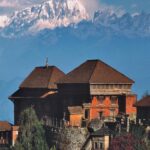Religious Significance of Kailash Mansarovar Tour
- Kailash is home to Lord Shiva and his wife Parvati
- It is viewed as the mythical mount Meru
- Hindus believe Mansarovar was created by Lord Brahma
Kailash and lake Manasarovar are sacred to the Hindus who take Kailash Mansarovar Tour as the ultimate pilgrimage. Mount Kailash is the abode of Lord Shiva; where he lived with wife Parvati. He danced upon the top of the mountain, drawing the entirety of the cosmic energy to him and attuning it to the frequency of his steps. It is here in Kailash that Shiva became Natraj, Adi Shankara, Maha Rudra and Bhairava. Mount Kailash is also the embodiment of the mythical Mount Meru (Sumeru). Hindu legends and mythology hold Mount Meru as the centre of the Universe; with every heavenly orb circling around it.

When Hindus go for a Kailash Mansarovar Tour, they do it with the belief that doing so will wash all their sins away and they attain ‘Swargaloka’ – the heavens, upon death. Mount Kailash trek is the pathway to ultimate salvation for the Hindus. It is worthwhile to mention that the Pandavas in Mahabharata also headed north for Kailash at the end of their reign in Hastinapur.
Lake Manasarovar is the place where lord Shiva relaxed – often descending from the top of Mount Kailash and swimming with the swans. The literal translation of manasarovar is ‘Mind Borne Lake’ – ‘manasa’: mind, ‘sarovara’: ‘lake’; meaning the lake that Brahma created in his mind.
Other gems of Kailash Mansarovar Tour – Rakshasha Tal and Gauri Kunda
- Rakshasha Tal – symbolized as demon’s lake, is a twin of Mansarovar
- Gauri Kunda, associated with goddess Parvati, also lies nearby

Lake Mansarovar lies very close to the nearby ‘Rakshasha Tal’ – meaning demon’s lake; only separated by small piece of land. The two lakes are connected by an adjoining channel. It is an interesting coincidence that the sacred place of the Hindus – who believe good and evil always exist together, has the manifestation of that concept in physical reality with two lakes of absolute opposite significance existing together. ‘Rakshasha Tal’ does well to live up to its name – its circumference is filled with marshy, unnavigable stretches.
Further away from Kailsh-Manasarovar is the ‘Gauri Kunda’ (Gauri meaning goddess Parvati). This lake is where Shiva-Parvati’s son Ganesha was bathed: giving him new life after his head was cut and replaced with an Elephant’s head instead. It is believed that Gauri’s motherly love kept Ganesha alive and the lake is the physical representation of that love. Hindus circumambulate Lake Mansarovar (90 Km in circumference) and the base of Kailash (52 km) but never attempt to climb atop the mountain. It is believed that it is an act of sin and misfortune befalls on those who try to do so.
Kailash Mansarovar Tour: Significance for other religions

- Buddhists, Jains and Bonpos also view Kailash as Mount Meru
- Buddhists and Bonpos also do mountain Parikrama (going around it)
- Jains believe Risabhnath attained salvation here
There is mention of Mount Meru in Buddhist cosmology too and mount Kailash is believed to be that mountain by the Buddhists. For hundreds of years Buddhists have been going to Mount Kailash, believing ancient Buddhas attained Nirvana (Moksha) here. Lake Manasarovar is believed to be the place where Maya conceived Buddha. Jainism also depicts Kailash as Mount Meru, the universal centre. Further it is here, Jains believe, that Tirthankara Rishabhanath attained salvation. The mountain and the lake also has huge significance in Tibetan shamanic religion Bon. They have deep attaching sentiment with Kailash-Mansarovar, maintaining Mount Kailash as the centre of the world, and believing their founder, Tonpa Shenrab, bathed in the lake during his visit to Tibet. Hindus and Buddhists complete Mount Kailash trek by going around the mountain in clockwise direction (Parikrama) while the Bonpos take the other way round (Kora).










